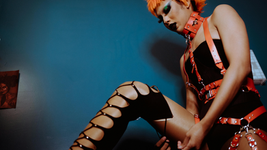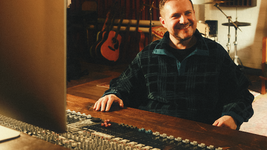‘The Vinyl Factory – Reverb’ At 180 Studios
- Oisín McGilloway
- Jun 24, 2024
- 5 min read

At the end of May, 180 Studios opened the ‘Reverb’ exhibition in partnership with The Vinyl Factory to celebrate the past 20 years of the record label’s work with artists at the cutting edge of sonic art. As with every 180 exhibition (the concurrent exhibition ‘Back in the Dazed: Rankin 1991-2001’ is another prime example), collaboration is at the forefront, a fact that needs to be remembered through what is a slightly jarring collection of pieces that sometimes prioritises the quality of sound over visuals, but one that points unidirectionally towards the singular vision of The Vinyl Factory.
One theme that facilitated this directionality, a principle that we could say governs all music, is time. Not only is the whole exhibition justified by time, but it concerns music, the prime manipulator of time, as well as vinyl records, which are—a bit like celluloid film or commercial architecture—a pre-digital remnant of finite materiality. Vigil 2.0, a collaborative piece by Caterina Barbieri and Ruben Spini, presents a block of ice suspended in front of a circular screen showing a sunrise, the block of ice—which dorns a hand print—slowly dripping, forming a puddle underneath, which reflects the sunrise back to the viewer. The music that plays behind is one of Barbieri’s own compositions, an ethereal synth piece that seems to have no beginning or end. Like the sunrise behind, which is reversed to sunset in order to start the process again, the music doesn’t follow the rises and falls of modern music; it is as unpunctuated as the oscillatory movement of the sun. Contrasting this is the block of ice, the medium through which we see the image of the sun, which not only has a definite finality but one that is metered by our interaction with it (the more bodies in the room, the hotter it gets, thus the quicker the ice melts). What is at first a strikingly beautiful artwork becomes a reminder that music, in vinyl form, used to have a lifecycle, a fact that when articulated in such a way steeply increases the value attributed to music.

The reason I spend so long on what I think was one of the best pieces in the exhibition is because it was, in the way it interacted with the viewer, truly immersive—just like music. The same, however, can’t be said for some of the other pieces, many of which were film installations of many hours in duration. The way the themes of time are stretched over Stan Douglas’ ISDN, a two-channel collection of freestyles from various rappers that are configured together in a turn-taking system that takes four weeks to repeat, is clear to see. In one room, two large screenings show the two channels of Douglas’ work; one is a recording from London, while the other is from Cairo. The way the piece is organised, as well as the message of transcendent musical connection, make for an interesting piece, but the sheer length of it makes it difficult to feel immersed. Stan Douglas also opens the exhibition with his six-hour film Luanda-Kinshasa, a loop of footage of jams at Colombia Records legendary 30th Street studio. The grooves are infectious, and the virtuosity radiates from the screen, but the length takes away a lot of the purpose of the film as an exhibition piece. As films, Douglas’ works are incredible, but, particularly given the nature of both, they feel more like a performance that grounds the audience in a separate position in the composition, going against the immersive aims laid out in, for example, Vigil 2.0.
There were other pieces, however, that created immersion perhaps the most effectively through interaction. The turntable that allows you to mix a selection of records in Carsten Nicolai’s Bausatz Noto and Es Devlin’s Screenshare, a notebook-page collage that you can take away with you, does not really complement the other approaches to the theme throughout the exhibition, yet do as good a job. While Vigil 2.0 and Douglas’ works manipulate time to explore the subject, the interactive pieces focus on the materiality of vinyl, which is something that modern music has lost. Es Devlin’s piece may not so explicitly show music or any manipulation of time, but it symbolises the other side of her career, which is as a stage designer—a factor of live musical performance, and one of the few material experiences of music we have left in the mainstream. Even The Vinyl Factory’s own piece 100 Records, a room filled with a hundred of the records they have produced (many of which are from artists that appear in the exhibition), plays on materiality by turning the medium of the music into the artistic artefact itself—there is no way of us to know what the record sounds like, we can only look at the covers and the grooves in the records and contemplate what they may sound like.

Of course, the most salient piece, the piece that rounds up this subtle narrative that weaves its way through an otherwise jarring exhibition, is the collaboration between modern maestro Hito Steyerl and hip-hop maverick Kojey Radical. The sprawling array of AI-generated flowers and insects on differently shaped screens, sprawled in an unorganised formation through a large room, seems—within the context of the exhibition—to be a warning to digitality. With the war against AI in songwriting waging on, this piece grounds the patchy celebration on vinyl in conversations around the fears of digitality, and the control that corporations have as music is pushed into the computerised ether. Fittingly titled, This Is The Future shows us what will happen if we let go of vinyl, in a much more severe, yet nonetheless salient advocation for vinyl records than any other exhibition in ‘Reverb’.
Another honourable mention in this exhibition was Gabriel Moses’ short film Ijó which used music to create a basis of unease within a cryptic commentary on race and gender fragility. Similarly, Kahlil Joseph’s BLKNWS was perhaps the only experimental video piece to utilise the exhibition space to create an immersive, dual-channel experience of how black suffering and black musical culture are inextricably aligned.
One can only commend how much effort was put into the final exhibit, Devon Turnbull’s Hifi Listening Room Dream No.1. What was just a deep listening experience, using industrial-sized speakers connected to a turntable, where you had to take off your shoes and inhale incense, ended up being the best way to end an exhibition celebrating vinyl: by showcasing the potential that vinyl has as the optimum material for experiencing music. If the immersive powers of music shone through any part of this exhibition it was here, in a successful and beautiful end to ‘Reverb’.


































Comments